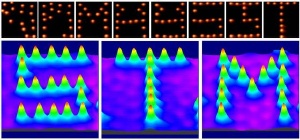Apr 2 2009
On a fundamental level, the ability to assemble patterns of single molecules on a surface can provide researchers with important information on the interactions between neighboring molecules. Molecules that are adsorbed on a surface can be moved by pushing or pulling them with an STM (scanning tunneling microscope) tip. However, this can be a slow process, and can easily result in damage to both the fragile tip of STM or to the adsorbed molecule.
 A group of methyl thiolate molecules adsorbed on a copper surface can be repeatedly rearranged to spell out the letters of STM.
A group of methyl thiolate molecules adsorbed on a copper surface can be repeatedly rearranged to spell out the letters of STM.
Writing in Physical Review B*, Yousoo Kim and colleagues from the RIKEN Advanced Science Institute in Wako have reported a non-contact method for rapidly and accurately positioning single molecules. The researchers demonstrate their method by preparing patterns of methyl thiolate ions adsorbed on a copper surface. Each molecule of thiolate is adsorbed on the copper surface at a so-called hollow site—spaces that exist between the arrangement of copper atoms at the surface. When an electric field is applied between the STM tip and the surface, the molecules’ vibrations are increased—the chemical bonds in the molecule can be considered as small springs—and the molecule hops to an adjacent hollow site. The researchers showed that this description of the hopping movement is correct by showing that the voltage that must be applied corresponds to the known vibrational frequency of the carbon–sulfur bond in the methyl thiolate.
This vibrational excitation has been observed before but, the electric field has always been applied directly at the center of the molecule, and the movement of the molecules was random in nature. Kim and colleagues, however, investigated the effect of applying the electric field slightly off center. They showed that they could not only cause the molecule to move to an adjacent hollow site, but they could control the direction in which it moved in a highly selective fashion. As a demonstration, the researchers used their method to arrange molecules of methyl thiolate to produce the letters ‘STM’.
It has been shown previously that when adsorbed on a copper surface, the methyl thiolate probably bears a negative charge. This is supported by the movement direction of the methyl thiolate. When the STM tip is negatively charged, a repulsive electrostatic force causes the molecule to hop away from the tip. Similarly, when the STM tip is positively charged, the molecules hop towards the tip. Precise positioning of molecules in this way will be important for the development of functional materials such as those used in memory devices.
*Ohara, M., Kim, Y. & Kawai, M. Electric field response of a vibrationally excited molecule in an STM junction. Physical Review B 78, 201405(R) (2008).